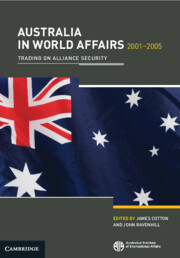Book contents
- Frontmatter
- Contents
- Illustrations
- Contributors
- Preface
- Abbreviations
- Part 1 The Foreign Policy Scene
- Part 2 Relationships
- 2 Extreme Allies: Australia and the USA
- 3 Rebuilding Engagement: Australia and South-East Asia
- 4 Australia and Japan: Challenges and Opportunities
- 5 Australia and China: Towards a Strategic Partnership?
- 6 Australia, Britain, and the European Union
- 7 Australia and Fragile States in the Pacific
- 8 Perfect Strangers: Australia and West Asia
- Part 3 Issues
- Part 4 Foreign Policy in the Political Process
- Survey Sources
- References
- Index
7 - Australia and Fragile States in the Pacific
from Part 2 - Relationships
Published online by Cambridge University Press: 04 May 2024
- Frontmatter
- Contents
- Illustrations
- Contributors
- Preface
- Abbreviations
- Part 1 The Foreign Policy Scene
- Part 2 Relationships
- 2 Extreme Allies: Australia and the USA
- 3 Rebuilding Engagement: Australia and South-East Asia
- 4 Australia and Japan: Challenges and Opportunities
- 5 Australia and China: Towards a Strategic Partnership?
- 6 Australia, Britain, and the European Union
- 7 Australia and Fragile States in the Pacific
- 8 Perfect Strangers: Australia and West Asia
- Part 3 Issues
- Part 4 Foreign Policy in the Political Process
- Survey Sources
- References
- Index
Summary
During the first five years of the twenty-first century the Howard Government took on a more activist role in the South Pacific. This trend was influenced by the ‘war on terror’, particularly the Bali bombings, which struck home in a manner that the 11 September attacks could not, but it also firmly reflected policy orthodoxies. This is not to say that responding to terrorism closer to home has not become a justification for intervention in the region, but it must be acknowledged that declaratory policy was not always matched by operational realities. The ‘war on terror’ opened up the political space in which increased intervention in the South Pacific could be undertaken, but events within the region itself were the central factor contributing to intervention. In particular, domestic crises in Solomon Islands and Papua New Guinea, and to a lesser extent Nauru, presented major challenges for Australia, and the creation and maintenance of an environment conducive to intervention was a significant foreign policy shift by the government.
Keywords
- Type
- Chapter
- Information
- Australia in World Affairs 2001–2005Trading on Alliance Security, pp. 111 - 127Publisher: Cambridge University PressFirst published in: 2024



